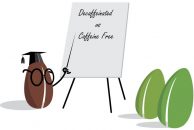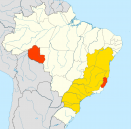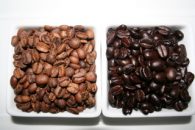
According to the American Heritage Dictionary, coffee is a collection of tropical shrubs or trees belonging to the genus Coffea. The genus is made up of more than 500 genera, which in turn are made up of an additional 6,000 member species.
Carolus Linneaus was the Swedish botanist to identify and describe the genus before anyone else in the eighteenth century. He also went on to define Coffea Arabica. Botanists have never been able to agree on a precise classification for coffee. This is due perhaps to the fact that coffee plants can range from tiny shrubs to trees reaching more than sixteen feet (five meters).
Coffee Plant:
Out of the thousands of coffee species, Coffea canephora (also called Robusta) and
Coffea arabica are the only two which are actively cultivated and prized for their seeds. After drying, the seeds are roasted and ground so an aromatic hot beverage can be prepared.
Members of the Rubiaceae, Coffea plants are evergreen shrubs that have the potential to reach a height of five meters (16.4 ft.) if not pruned. The dark green leaves are glossy and ten to fifteen centimetres in length and six cm (2.4 inches) wide. The plant generates bunches of white flowers with pleasing fragrance.
The fruit of the plant has an oval shape and is approximately 1.5 cm (0.6 in.) long. The fruit is green before it reaches maturity and as it becomes ripe it changes to yellow and finally deep red colour upon ripening. Each piece of fruit houses two seeds, but less than ten per-cent of the berries have only a single seed. They are given the name of peaberries.
Coffee Cherries:
The fruit of a coffee plant is called a coffee cherry. The skin is known as the exocarp, under which we find a thin fleshy layer called the mesocarp. Further in the fruit you find a slimy layer known as the parenchyma. This slimy encasing surrounds the cherry seed and is given the name endocarp or parchment. The seeds themselves lie next to each other hidden by the parchment, and each is individually wrapped by yet another thin delicate membrane. This final covering is called the spermoderm or more simply “silverskin”.
The Journey from the Plant to the Cup:
Before reaching your cup, coffee has to undergo no less than seven crucial processes that are executed by seven unconnected parties living in two or more separate parts of the planet. The process begins by someone growing the plant and picking the fruit. The next party purchases the fruit and isolates the seeds from the fleshy portion and dries them. At this stage they are known as beans due their resemblance to actual beans. An exporter who purchases the dried beans is the next step in line. At this point the exporter may combine beans from a variety of processing units and bag them together before shipping.
The fourth party in the process is the importer who brings the seeds into the importing country. He does not manipulate the beans in any way, merely sells them onto the roaster. In the hands of the roaster, the coffee beans undergo the most significant procedure that impacts the flavour of the drink – roasting. The roaster may also combine beans from different crops or areas of the world, with the intent of controlling the price or quality of the beans.
The retailer makes every effort to ensure that the processed coffee is sold before it becomes stale. The last handler of the coffee beans is the consumer who purchases the bean grounds or the whole bean and grinds them before actually using them to make the coffee beverage.
Speciality Coffee Vs. Commercial:
Speciality coffee is prized due to the fact that its roots can be traced all the way back to not only the country of origin but the region and even the farm where it was cultivated. Since the quality of a coffee is governed by things like the variety, altitude of cultivation, processing method, and harvest dates; knowing this information adds value to the coffee’s authenticity and guarantees quality. The information regarding the vital factors that impact flavour for commercial coffee is scarce. At best you may know the country of origin and perhaps sometimes growing region but nothing more.
Regardless of the fact that there are only two basic species of coffee plants (Arabica and Robusta) that are cultivated, Arabica alone has more than 160 varieties. Typica, Acaia, Bourbon, Caturra, Aatui and Gesha are among the better known, but there are loads of others. Each of these varieties offers its own unique range of taste profiles. A speciality coffee shop will have the details of the variety, and if the coffee being sold is a blend of different varieties, then the names of varieties and their percentages will also be provided. Furthermore, the roaster will also be able to provide the tasters’ notes or comments regarding that specific batch. With commercial coffee you will at most know if the coffee being purchased is Arabica or Robusta. There will be no information regarding percentages if the coffee is bended, nor will there be notes regarding taste. Commercial coffees only offer generic roast profiles like medium roast, dark roast, espresso roast etc.
Some coffee varieties can only be cultivated in very specific microclimates. This means only a limited amount of this variety can be cultivated in a season. Specialty coffee roasters can guarantee the quality of the beans they sell, as they deal with brokers specializing only in such coffees. Some such coffees are so limited that only one or two coffee roasters will be able to offer them for sale. Commercial coffee on the other hand, is mass produced to meet the ever growing demand. This makes it nearly impossible for commercial producers to provide single origin coffees. Due to the large scale of production needed to meet demand, commercial producers usually just purchase whatever coffee is available from any region and just end up combining everything randomly.
The Speciality Coffee Association of America (SCAA), sets specific standards for speciality coffee. Coffees in speciality category go through strict examinations and are graded for quality. Coffees are graded for factors like fungus damage, discoloration, dryness, presence of foreign matter, presence of broken/unripe/overripe beans and many other factors.
Cupping is yet another test for speciality coffee. This includes the roast profile determined in a given time limit of cup tasting. Things like flavour and aroma in addition to acidity, sweetness, aftertaste and other parameters are noted. Based on the outcome, the coffee is defined as being outstanding specialty, excellent specialty, or very good specialty. The remaining coffees are considered below speciality grade and denoted as exchange grade, average quality, commercial grade or off grade/below grade.
Needless to say, specialty roasters only use graded coffee with highest standing, while commercial producers use coffees below the speciality grades or a mix thereof.








